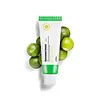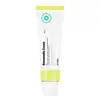What's inside
What's inside
 Key Ingredients
Key Ingredients

 Benefits
Benefits

 Concerns
Concerns

 Ingredients Side-by-side
Ingredients Side-by-side

Citrofortunella Microcarpa Fruit Extract
AntioxidantWater
Skin ConditioningButylene Glycol
HumectantCaprylic/Capric Triglyceride
MaskingNiacinamide
SmoothingCetearyl Alcohol
EmollientHydrogenated Poly(C6-14 Olefin)
EmollientPolyglyceryl-3 Methylglucose Distearate
Emulsifying1,2-Hexanediol
Skin ConditioningButyrospermum Parkii Butter
Skin ConditioningCitrus Aurantium Bergamia Fruit Oil
MaskingCitrus Aurantium Dulcis Peel Oil
MaskingMelia Azadirachta Flower Extract
Skin ConditioningMelia Azadirachta Leaf Extract
Skin ConditioningCurcuma Longa Root Extract
MaskingOcimum Tenuiflorum Extract
Skin ConditioningCorallina Officinalis Extract
Skin ConditioningYeast Extract
Skin ConditioningJasminum Officinale Flower/Leaf Extract
MaskingNelumbo Nucifera Flower Extract
Skin ConditioningFreesia Refracta Extract
Skin ConditioningIris Versicolor Extract
EmollientLeontopodium Alpinum Flower/Leaf Extract
Skin ConditioningLilium Candidum Bulb Extract
Skin ConditioningNarcissus Pseudo-Narcissus Flower Extract
Skin ConditioningCitrus Reticulata Peel Oil
MaskingRosa Damascena Flower Extract
MaskingPanthenol
Skin ConditioningPentylene Glycol
Skin ConditioningPolymethylsilsesquioxane
Vinyldimethicone
Cetearyl Glucoside
EmulsifyingGlyceryl Stearate
EmollientSilica
AbrasiveHydroxyacetophenone
AntioxidantHydroxyethyl Acrylate/Sodium Acryloyldimethyl Taurate Copolymer
Emulsion StabilisingCaprylyl Glycol
EmollientAcrylates/C10-30 Alkyl Acrylate Crosspolymer
Emulsion StabilisingTromethamine
BufferingAdenosine
Skin ConditioningAscorbic Acid
AntioxidantEthylhexylglycerin
Skin ConditioningDisodium EDTA
Citrofortunella Microcarpa Fruit Extract, Water, Butylene Glycol, Caprylic/Capric Triglyceride, Niacinamide, Cetearyl Alcohol, Hydrogenated Poly(C6-14 Olefin), Polyglyceryl-3 Methylglucose Distearate, 1,2-Hexanediol, Butyrospermum Parkii Butter, Citrus Aurantium Bergamia Fruit Oil, Citrus Aurantium Dulcis Peel Oil, Melia Azadirachta Flower Extract, Melia Azadirachta Leaf Extract, Curcuma Longa Root Extract, Ocimum Tenuiflorum Extract, Corallina Officinalis Extract, Yeast Extract, Jasminum Officinale Flower/Leaf Extract, Nelumbo Nucifera Flower Extract, Freesia Refracta Extract, Iris Versicolor Extract, Leontopodium Alpinum Flower/Leaf Extract, Lilium Candidum Bulb Extract, Narcissus Pseudo-Narcissus Flower Extract, Citrus Reticulata Peel Oil, Rosa Damascena Flower Extract, Panthenol, Pentylene Glycol, Polymethylsilsesquioxane, Vinyldimethicone, Cetearyl Glucoside, Glyceryl Stearate, Silica, Hydroxyacetophenone, Hydroxyethyl Acrylate/Sodium Acryloyldimethyl Taurate Copolymer, Caprylyl Glycol, Acrylates/C10-30 Alkyl Acrylate Crosspolymer, Tromethamine, Adenosine, Ascorbic Acid, Ethylhexylglycerin, Disodium EDTA
Hamamelis Virginiana Water
AstringentButylene Glycol
HumectantCetearyl Alcohol
Emollient1,2-Hexanediol
Skin ConditioningIsotridecyl Isononanoate
EmollientGlyceryl Stearate
EmollientNiacinamide
SmoothingPolymethylsilsesquioxane
Citrus Aurantium Dulcis Oil
MaskingSalvia Sclarea Oil
MaskingArgania Spinosa Kernel Oil
EmollientRhus Semialata Gall Extract
Skin ConditioningSesamum Indicum Seed Oil
EmollientSerenoa Serrulata Fruit Extract
Skin ConditioningCinnamomum Cassia Bark Extract
MaskingPentylene Glycol
Skin ConditioningMethyl Methacrylate Crosspolymer
Ammonium Acryloyldimethyltaurate/Vp Copolymer
Caprylic/Capric Triglyceride
MaskingCaprylyl Methicone
Skin ConditioningHydroxyacetophenone
AntioxidantTromethamine
BufferingAdenosine
Skin ConditioningHexylene Glycol
EmulsifyingCapryloyl Glycine
CleansingBeta-Sitosterol
Emulsion StabilisingSarcosine
Skin ConditioningTocopherol
AntioxidantCarbomer
Emulsion StabilisingDisodium EDTA
Limonene
PerfumingLinalool
PerfumingHamamelis Virginiana Water, Butylene Glycol, Cetearyl Alcohol, 1,2-Hexanediol, Isotridecyl Isononanoate, Glyceryl Stearate, Niacinamide, Polymethylsilsesquioxane, Citrus Aurantium Dulcis Oil, Salvia Sclarea Oil, Argania Spinosa Kernel Oil, Rhus Semialata Gall Extract, Sesamum Indicum Seed Oil, Serenoa Serrulata Fruit Extract, Cinnamomum Cassia Bark Extract, Pentylene Glycol, Methyl Methacrylate Crosspolymer, Ammonium Acryloyldimethyltaurate/Vp Copolymer, Caprylic/Capric Triglyceride, Caprylyl Methicone, Hydroxyacetophenone, Tromethamine, Adenosine, Hexylene Glycol, Capryloyl Glycine, Beta-Sitosterol, Sarcosine, Tocopherol, Carbomer, Disodium EDTA, Limonene, Linalool
Ingredients Explained
These ingredients are found in both products.
Ingredients higher up in an ingredient list are typically present in a larger amount.
1,2-Hexanediol is a synthetic liquid and another multi-functional powerhouse.
It is a:
- Humectant, drawing moisture into the skin
- Emollient, helping to soften skin
- Solvent, dispersing and stabilizing formulas
- Preservative booster, enhancing the antimicrobial activity of other preservatives
Adenosine is in every living organism. It is one of four components in nucleic acids that helps store our DNA.
Adenosine has many benefits when used. These benefits include hydrating the skin, smoothing skin, and reducing wrinkles. Once applied, adenosine increases collagen production. It also helps with improving firmness and tissue repair.
Studies have found adenosine may also help with wound healing.
In skincare products, Adenosine is usually derived from yeast.
Learn more about AdenosineButylene Glycol (or BG) is used within cosmetic products for a few different reasons:
Overall, Butylene Glycol is a safe and well-rounded ingredient that works well with other ingredients.
Though this ingredient works well with most skin types, some people with sensitive skin may experience a reaction such as allergic rashes, closed comedones, or itchiness.
Learn more about Butylene GlycolThis ingredient is an emollient, solvent, and texture enhancer. It is considered a skin-softener by helping the skin prevent moisture loss.
It helps thicken a product's formula and makes it easier to spread by dissolving clumping compounds.
Caprylic Triglyceride is made by combining glycerin with coconut oil, forming a clear liquid.
While there is an assumption Caprylic Triglyceride can clog pores due to it being derived from coconut oil, there is no research supporting this.
Learn more about Caprylic/Capric TriglycerideCetearyl alcohol is a mixture of two fatty alcohols: cetyl alcohol and stearyl alcohol. It is mainly used as an emulsifier. Emulsifiers help prevent the separation of oils and products. Due to its composition, it can also be used to thicken a product or help create foam.
Cetearyl alcohol is an emollient. Emollients help soothe and hydrate the skin by trapping moisture.
Studies show Cetearyl alcohol is non-toxic and non-irritating. The FDA allows products labeled "alcohol-free" to have fatty alcohols.
This ingredient is usually derived from plant oils such as palm, vegetable, or coconut oils. There is debate on whether this ingredient will cause acne.
Due to the fatty acid base, this ingredient may not be Malassezia folliculitis safe.
Learn more about Cetearyl AlcoholDisodium EDTA plays a role in making products more stable by aiding other preservatives.
It is a chelating agent, meaning it neutralizes metal ions that may be found in a product.
Disodium EDTA is a salt of edetic acid and is found to be safe in cosmetic ingredients.
Learn more about Disodium EDTAGlyceryl Stearate is a mix of glycerin and stearic acid.
It is used to stabilize the mixing of water and oil ingredients. By preventing these ingredients from separating, it can help elongate shelf life. It can also help thicken the product's texture.
As an emollient, it helps soften skin and supports barrier-replenishing ingredients.
In cosmetics, Glyceryl Stearate is often made from vegetable oils or synthetically produced.
This ingredient may not be fungal-acne safe
Fun fact: The human body also creates Glyceryl Stearate naturally.
Learn more about Glyceryl StearateHydroxyacetophenone is antioxidant with skin conditioning and soothing properties. It also boosts the efficiency of preservatives.
This ingredient is not irritating or sensitizing.
Niacinamide is a multitasking form of vitamin B3 that strengthens the skin barrier, reduces pores and dark spots, regulates oil, and improves signs of aging.
And the best part? It's gentle and well-tolerated by most skin types, including sensitive and reactive skin.
You might have heard of "niacin flush", or the reddening of skin that causes itchiness. Niacinamide has not been found to cause this.
In very rare cases, some individuals may not be able to tolerate niacinamide at all or experience an allergic reaction to it.
If you are experiencing flaking, irritation, and dryness with this ingredient, be sure to double check all your products as this ingredient can be found in all categories of skincare.
When incorporating niacinamide into your routine, look out for concentration amounts. Typically, 5% niacinamide provides benefits such as fading dark spots. However, if you have sensitive skin, it is better to begin with a smaller concentration.
When you apply niacinamide to your skin, your body converts it into nicotinamide adenine dinucleotide (NAD). NAD is an essential coenzyme that is already found in your cells as "fuel" and powers countless biological processes.
In your skin, NAD helps repair cell damage, produce new healthy cells, support collagen production, strengthen the skin barrier, and fight environmental stressors (like UV and pollution).
Our natural NAD levels start to decline with age, leading to slower skin repair, visible aging, and a weaker skin barrier. By providing your skin niacinamide, you're recharging your skin's NAD levels. This leads to stronger, healthier, and younger looking skin.
Another name for vitamin B3 is nicotinamide. This vitamin is water-soluble and our bodies don't store it. We obtain Vitamin B3 from either food or skincare. Meat, fish, wheat, yeast, and leafy greens contain vitamin B3.
The type of niacinamide used in skincare is synthetically created.
Learn more about NiacinamidePentylene glycol is typically used within a product to thicken it. It also adds a smooth, soft, and moisturizing feel to the product. It is naturally found in plants such as sugar beets.
The hydrophilic trait of Pentylene Glycol makes it a humectant. As a humectant, Pentylene Glycol helps draw moisture from the air to your skin. This can help keep your skin hydrated.
This property also makes Pentylene Glycol a great texture enhancer. It can also help thicken or stabilize a product.
Pentylene Glycol also acts as a mild preservative and helps to keep a product microbe-free.
Some people may experience mild eye and skin irritation from Pentylene Glycol. We always recommend speaking with a professional about using this ingredient in your routine.
Pentylene Glycol has a low molecular weight and is part of the 1,2-glycol family.
Learn more about Pentylene GlycolPolymethylsilsesquioxane is a silicone used as a film forming agent.
When applied to the skin, this ingredient creates an invisible film on the surface. This film still allows oxygen to pass through, but prevents moisture from escaping. This can help condition and hydrate the skin. It also leaves a silky feel when applied.
Polymethylsilsesquioxane has not been shown to clog pores. It has been deemed safe to use up to 55%, but most cosmetics use much less.
If you have concerns about using this ingredient, we recommend speaking with a professional.
Learn more about PolymethylsilsesquioxaneTromethamine helps balance the pH and improve the texture of a product. It is synthetically created.
As an emulsifier, Tromethamine prevents oil and water ingredients from separating. This helps stabilize the product and elongate a product's shelf life. Tromethamine also makes a product thicker.
Tromethamine helps balance the pH level of a product. Normal pH level of skin is slightly acidic (~4.75-5.5). The acidity of our skin is maintained by our glands and skin biome. Being slightly acidic allows our skin to create an "acid mantle". This acid mantle is a thin barrier that protects our skin from bacteria and contaminants.
Oral Tromethanmine is an anti-inflammatory drug but plays the role of masking, adding fragrance, and/or balancing pH in skincare.
1,3-Propanediol, 2-amino-2-(hydroxymethyl)-
Learn more about Tromethamine